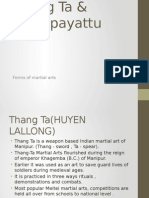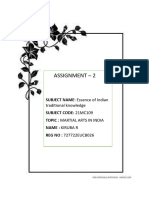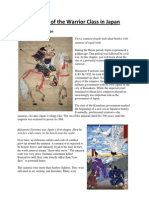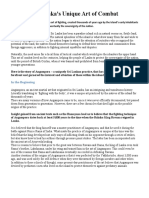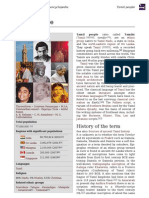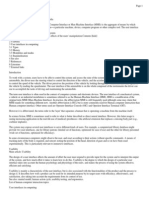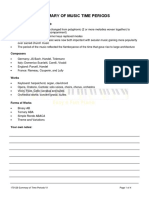Vettu
Vettu
Uploaded by
Maha DhinaharCopyright:
Available Formats
Vettu
Vettu
Uploaded by
Maha DhinaharOriginal Description:
Original Title
Copyright
Available Formats
Share this document
Did you find this document useful?
Is this content inappropriate?
Copyright:
Available Formats
Vettu
Vettu
Uploaded by
Maha DhinaharCopyright:
Available Formats
Silambam
From Wikipedia, the free encyclopedia
Jump to navigationJump to search
"Silambattam" redirects here. For the 2008 Indian film, see Silambattam (film).
Silambam
Silambam vector.svg
Also known as Silambattam, Chilambam, Chilambattam
Focus Weapons
Hardness Semi-contact
Country of origin India
Creator Traditionally Agastya
Olympic sport No
Official website silambam.world
Tamil A.svg Tamil is written in a non-Latin script. Tamil text used in this article
is transliterated into the Latin script according to the ISO 15919 standard.
Silambam is a weapon-based Indian martial art originating in South India in the
Indian subcontinent. This style is mentioned in Tamil Sangam literature circa 400
BCE.[1] The World Silambam Association is the official international body of
Silambam.
Contents
1 Origin
2 Training
2.1 Weapons
2.2 Kuttu Varisai
3 World initiatives
4 In popular culture
5 See also
6 References
Origin
References in the Silappadikkaram and other works of the Sangam literature show
that Silambam has been practiced since at least the 4th century BC.[2] It derives
from the Tamil word silam, meaning hill. The term silambambu referred to a
particular type of bamboo from the Kurinjimala (kurinji hills) in present-day
Kerala. Thus silambam was named after its primary weapon, the bamboo staff.[3] It
may have earlier used for self-defense and to ward off animals in the Kurinji hills
and later evolved into the present-day martial art.[4] Bamboo staffs – as well as
swords, pearls and armor – were in great demand from foreign traders.[5][6]
The ancient city of Madurai formed as the point of focus of Silambam's spreading.
The Silambam staff was acquired by the Egyptians, Greeks and Romans and was spread
back to the Middle East, Europe and North Africa. The Tamil Kingdom which
encompassed Southern India and Sri Lanka spread it throughout the Southeast Asia.
[7]
The Kings Puli Thevar and Dheeran Chinnamalai had armies of Silambam soldiers named
"Thadii Pattalam." Veerapandiya Kattabomman, Chinna Maruthu and Periya Maruthu
(1760–1799) relied mainly on their Silambam prowess in warfare against the British
Army.[5] Indian martial arts and other related martial arts practices suffered a
decline after the British colonists banned Silambam and promoted modern military
training, which favored firearms over traditional weaponry.
Training
The first stages of Silambam practice are meant to provide a foundation for
fighting, and also preparatory body conditioning. This includes improving
flexibility, agility, and hand-eye coordination, kinesthetic awareness, balance,
strength, speed, muscular and cardiovascular stamina.[8][9]
You might also like
- Alexandre DumasDocument3 pagesAlexandre DumasGeorgian National Museum100% (1)
- Thomas Stamford Raffles: Schemer or Reformer?From EverandThomas Stamford Raffles: Schemer or Reformer?Rating: 4.5 out of 5 stars4.5/5 (2)
- A Response To 'Silence Demands A Rapture'Document10 pagesA Response To 'Silence Demands A Rapture'PDNo ratings yet
- Midnight's ChildrenDocument2 pagesMidnight's ChildrenKrisven Mae R. ObedoNo ratings yet
- SilambamDocument2 pagesSilambamMaha DhinaharNo ratings yet
- Martial ArtsDocument4 pagesMartial ArtsJoderick SherwinNo ratings yet
- Chinna Maruthu and Periya MaruthuDocument1 pageChinna Maruthu and Periya MaruthualiNo ratings yet
- Origin of Martial ArtsDocument3 pagesOrigin of Martial ArtsvmsudhiNo ratings yet
- History of Silambam Martial Art FormDocument2 pagesHistory of Silambam Martial Art FormKoushani RoyNo ratings yet
- SilambamDocument5 pagesSilambamDoktormin106100% (1)
- Silambam Fencing Rules BookDocument60 pagesSilambam Fencing Rules BookGetafix67% (3)
- Angam PoraDocument3 pagesAngam PorasudNo ratings yet
- ArnisDocument19 pagesArnisElaiza Marie ParumogNo ratings yet
- Tamil Marathi Hindi Tamilakam Tamil Nadu SilambamDocument1 pageTamil Marathi Hindi Tamilakam Tamil Nadu SilambamAnonymous 7II6KxNo ratings yet
- Comm PPT 1Document7 pagesComm PPT 1Prateek ChitambareNo ratings yet
- Ilmu BeladiriDocument94 pagesIlmu Beladirisafar_yayangNo ratings yet
- Kalaripayattu - WikipediaDocument16 pagesKalaripayattu - Wikipediasanjaychamathakariyil777No ratings yet
- Martial ArtsDocument10 pagesMartial ArtskirubasathyasheelaNo ratings yet
- Varma KalaiDocument3 pagesVarma Kalaistar893190100% (2)
- KalaripayattuDocument17 pagesKalaripayattuAr Junah100% (2)
- The Rise of The Warrior Class in Japan TextDocument17 pagesThe Rise of The Warrior Class in Japan Textapi-2334644940% (1)
- The Lightning Fast Bone Crushing Malay Art of WarDocument4 pagesThe Lightning Fast Bone Crushing Malay Art of Wardiamond68No ratings yet
- The History of the Samurai in a Nutshell: The Rise and Fall of Japan's Great Warrior ClassFrom EverandThe History of the Samurai in a Nutshell: The Rise and Fall of Japan's Great Warrior ClassNo ratings yet
- Early Life and Education: Pokhran-IIDocument1 pageEarly Life and Education: Pokhran-IIbalachandarNo ratings yet
- What Is Angam ?: Striking TechniquesDocument16 pagesWhat Is Angam ?: Striking TechniquessudNo ratings yet
- wings of fireDocument1 pagewings of fireshanbraidenrNo ratings yet
- Sri Lanka's Unique Art of Combat: in The BeginningDocument7 pagesSri Lanka's Unique Art of Combat: in The BeginningsudNo ratings yet
- Tamil LanguageDocument13 pagesTamil LanguagePravin RamNo ratings yet
- Sports in Tamil Nadu - WikipediaDocument12 pagesSports in Tamil Nadu - WikipediasathibhalajiNo ratings yet
- ArnisDocument13 pagesArnisbradNo ratings yet
- FULLTEXT06Document46 pagesFULLTEXT06Joseph AntonyNo ratings yet
- UntitledDocument2 pagesUntitledAde RianNo ratings yet
- On Tamil MilitarismDocument76 pagesOn Tamil MilitarismSharmalan ThevarNo ratings yet
- ArnisDocument13 pagesArnisRhoy A. Yutuc100% (1)
- Indian National MovementDocument7 pagesIndian National MovementDevi PriyaNo ratings yet
- Tamil MilitarismDocument58 pagesTamil MilitarismPravin Ram0% (1)
- Tamil PeopleDocument18 pagesTamil PeoplePravin Ram100% (1)
- Indonesia: Silat (Minangkabau: Silek) Is A Collective Word For Indigenous Martial Arts From A Geo-CulturalDocument3 pagesIndonesia: Silat (Minangkabau: Silek) Is A Collective Word For Indigenous Martial Arts From A Geo-CulturalZul MdNo ratings yet
- Samurais Lunes b2-1Document2 pagesSamurais Lunes b2-1NICOL VERGARA CABRERANo ratings yet
- Samurai: Art of Armor: Amurai Warriors Ruled Apan For Nearly ADocument22 pagesSamurai: Art of Armor: Amurai Warriors Ruled Apan For Nearly ABrandon HernándezNo ratings yet
- Sachin Tendulkar: Sania NehwalDocument11 pagesSachin Tendulkar: Sania NehwalAnkur ChopraNo ratings yet
- Manual Krav MagaDocument252 pagesManual Krav Maganumbker100% (3)
- Krav Maga Isreali Self DefenseDocument252 pagesKrav Maga Isreali Self DefenseMartinRampersadNo ratings yet
- Samurai Arms, Armour & the Tactics of Warfare: The Collected Scrolls of Natori-RyuFrom EverandSamurai Arms, Armour & the Tactics of Warfare: The Collected Scrolls of Natori-RyuNo ratings yet
- The Samurai Warrior: The Golden Age of Japan’s Elite Warriors 1560–1615From EverandThe Samurai Warrior: The Golden Age of Japan’s Elite Warriors 1560–1615No ratings yet
- The Lost Samurai: Japanese Mercenaries in South East Asia, 1593–1688From EverandThe Lost Samurai: Japanese Mercenaries in South East Asia, 1593–1688Rating: 3.5 out of 5 stars3.5/5 (2)
- Samurai Science: Armor, Weapons, and Battlefield StrategyFrom EverandSamurai Science: Armor, Weapons, and Battlefield StrategyNo ratings yet
- Way of the Samurai: A Chronicle of Honor and Steel: The Martial Arts CollectionFrom EverandWay of the Samurai: A Chronicle of Honor and Steel: The Martial Arts CollectionNo ratings yet
- Stalkers and Shooters: A History of SnipersFrom EverandStalkers and Shooters: A History of SnipersRating: 3.5 out of 5 stars3.5/5 (5)
- Fighting with the Fourteenth Army in Burma: Original War Summaries of the Battle Against Japan 1943–1945From EverandFighting with the Fourteenth Army in Burma: Original War Summaries of the Battle Against Japan 1943–1945No ratings yet
- War Elephant: Mighty Beasts and Their Impact on Ancient BattlefieldsFrom EverandWar Elephant: Mighty Beasts and Their Impact on Ancient BattlefieldsNo ratings yet
- The Book of Five Rings (Rediscovered Books): With linked Table of ContentsFrom EverandThe Book of Five Rings (Rediscovered Books): With linked Table of ContentsNo ratings yet
- MALAYS IN UNIFORM: THEIR FOOTPRINTS IN THE ANNALS OF HISTORY IN CEYLON/SRI LANKAFrom EverandMALAYS IN UNIFORM: THEIR FOOTPRINTS IN THE ANNALS OF HISTORY IN CEYLON/SRI LANKANo ratings yet
- Pinyin Table2 For Easy LearningDocument1 pagePinyin Table2 For Easy LearningscribduserforeverNo ratings yet
- User Interface - Definition From AnswersDocument3 pagesUser Interface - Definition From AnswersMuhammad Siddig HassanNo ratings yet
- Cake Magazine 6Document84 pagesCake Magazine 6Katia BarrosNo ratings yet
- Summary of Music Time Periods: BAROQUE PERIOD 1600 - 1750Document4 pagesSummary of Music Time Periods: BAROQUE PERIOD 1600 - 1750Isobel WilliamsNo ratings yet
- HDTV by Jiuzhou: Receiver Manufacturer, ChinaDocument5 pagesHDTV by Jiuzhou: Receiver Manufacturer, ChinaAlexander WieseNo ratings yet
- Dug WellsDocument2 pagesDug WellsPrinceEnopiaNo ratings yet
- Peace Proms Words For CopiesDocument5 pagesPeace Proms Words For Copiesapi-264865375No ratings yet
- Hermeneutics by Michael N. ForsterDocument62 pagesHermeneutics by Michael N. Forsterenieves78100% (1)
- Ascent Junior College: JUNIORS MAINS RESULT (30.11.2020)Document2 pagesAscent Junior College: JUNIORS MAINS RESULT (30.11.2020)Hemanth KarthikeyaNo ratings yet
- Therma Marine Inc. M2 Barge General Cleaning Schedule GuideDocument2 pagesTherma Marine Inc. M2 Barge General Cleaning Schedule GuiderasalesNo ratings yet
- Television WorksheetDocument1 pageTelevision WorksheetIzzyBella15No ratings yet
- Fallout Wasteland Warfare Dice Reference Sheet 1 Page PDFDocument1 pageFallout Wasteland Warfare Dice Reference Sheet 1 Page PDFJohnNo ratings yet
- Archetypal Criticism 1Document11 pagesArchetypal Criticism 1Kelly Kat100% (1)
- Idiomatic Expressions - Mini-Lesson 1.2 (6-8)Document6 pagesIdiomatic Expressions - Mini-Lesson 1.2 (6-8)Beatriz Eugenia Duque RestrepoNo ratings yet
- PDF Resume Weebly Bernadette WysockiDocument1 pagePDF Resume Weebly Bernadette Wysockiapi-536899653No ratings yet
- CPAR Prelim 2019-2020Document4 pagesCPAR Prelim 2019-2020Ruby Bie67% (3)
- Basic Acting Terms!: Given Circumstances!Document1 pageBasic Acting Terms!: Given Circumstances!kimmlisaNo ratings yet
- Honest IagoDocument10 pagesHonest IagoVanoiMariaStylesWilkinsonNo ratings yet
- What Is Conceptual ArtDocument28 pagesWhat Is Conceptual ArtKonstantin Koukos A90% (10)
- State Common Entrance Test Cell: 3012 Veermata Jijabai Technological Institute (VJTI), Matunga, MumbaiDocument83 pagesState Common Entrance Test Cell: 3012 Veermata Jijabai Technological Institute (VJTI), Matunga, MumbaiAmrut BhattNo ratings yet
- Missions in The Modern WorldDocument33 pagesMissions in The Modern WorldMoses OminoNo ratings yet
- Torii U.S. Army Garrison Japan Weekly Newspaper, Jul. 29, 2010 EditionDocument11 pagesTorii U.S. Army Garrison Japan Weekly Newspaper, Jul. 29, 2010 EditionCamp ZamaNo ratings yet
- Walsh Bay PerformanceDocument2 pagesWalsh Bay Performanceapi-309093506No ratings yet
- Sonata V in C Major BWV 529 For String Trio-Parts PDFDocument32 pagesSonata V in C Major BWV 529 For String Trio-Parts PDFdnikosd100% (1)
- Scientific InstrumentsDocument24 pagesScientific InstrumentsThe Western Electric & Scientific WorksNo ratings yet
- Polyurethane Thickeners UV Stabilizers PDFDocument2 pagesPolyurethane Thickeners UV Stabilizers PDFAPEX SONNo ratings yet
- Aldodonez Coanqui Adaluz: Give Leave Move Use WorkDocument3 pagesAldodonez Coanqui Adaluz: Give Leave Move Use WorkAdaLuzCoanquiNo ratings yet















